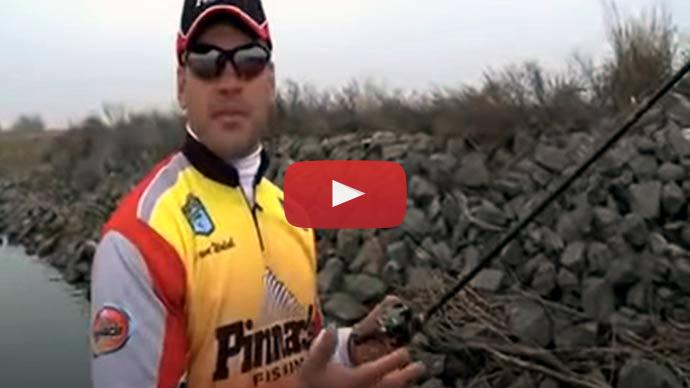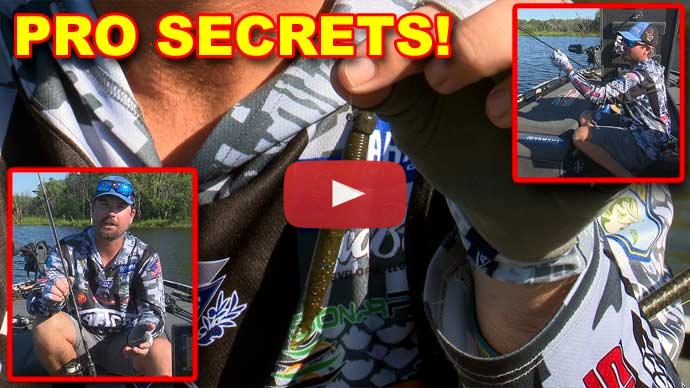Hey guys, Wes Logan here with BassResource. I'm going to be talking about wintertime fishing. It's a really interesting time of year to be on the water because you're not going to have near the people out there because most of the time people are going to be in the woods whether they're deer hunting or anything like that. You're definitely not going to have the pleasure boaters out there. You're not going to have to deal with that. The fishing can actually be really phenomenal just depending on the weather and what your water temperature is and that certain day.
I have noticed that in the wintertime, the fishing can be more day-to-day than any other time of year. When I say wintertime, I'm talking we're coming off the fall, you've got water temperatures falling, and you're going to be anywhere from mid-50s to late winter right before the spawn. You could get down into even the 40s.
Talking about the early winter coming off that fall transition, it can be really good because those fish are feeding up. They know it's going to get intense. The weather is going to be tough on them. Their metabolism is going to slow way down because they're just not going to need to exert all that energy with it being so cold. So they'll be feeding up really well.
You can a lot of times call your shots how you want to catch them, whether it's throwing a spinnerbait or a vibrating jig or a square bill down the bank or going and flipping some isolated cover or you'll still have the tail end of some schooling fish just depending on what lake and what reservoir you're on.
But again you're going to be dealing with fish that are, it's not going to be a fall transition but they're still going to be transitioning. Fish are always moving. They're always either swimming here or swimming there, chasing bait. But what can happen that time of year is the forage has been way up shallow, been in the backs of the creeks, and this doesn't go for all places, but if you have a relatively deeper place that you like to fish, those fish will sometimes readjust or not the fish, the bait fish will readjust and they could sometimes suspend out in the middle of the lake and they could be over 40, 50, 60 foot deep and the bait could be only 15 foot deep. Well those fish are going to suspend with them especially the colder that water gets because that's where all their bait is going to go and those big bait balls will just get out there and just kind of just roam around and those fish will stay up on them until they get real active and decide to run up there and eat them.
A big deal with that is and this time of year, not this time of year but this day and age in electronics and technology we've got the forward-facing sonar is really hard to beat in the wintertime just because those fish get out there and really get on nothing. The majority of them in the lake. You can still catch some shallow and I'll get into that in a minute but for the most part, those fish will follow that bait out there out deep and basically just hunker down up under them and when the shad go to die as the water gets colder those shad will fall down in the water column and they just really sit there and eat them.
But a really big deal on that with the new forward-facing sonar stuff we've got is a jerkbait is really good that time of year just depending on how deep they are depends on what depth jerk bait you want to have, but being able to see them really does help in that situation. A jigging spoon is very, very good that time of year. A lot better on in later into the winter when it gets really cold really intensely cold and that's probably getting into that 40-degree water temperature but again it's always bait-oriented.
So, swapping gears you can always stay shallow as well in that wintertime but your bait selection is going to revert back to almost that pre-spawn type deal. You're going to have your reds and your black and chartreuses because majority of the time, only on a few lakes, you're going to have stained water in the wintertime because you're going to have a lot of fronts rolling. You're going to have a lot of rain. It's going to muddy up all those creeks. It's going to blow out a bunch of places so it goes back to that protected pre-spawn deal that I've talked about before.
You want to find those places that are away from a north wind that may not have water running into them. Sometimes, those are the most consistent in the wintertime as far as shallow water fishing. Definitely want to have some type of hard cover. Hardly ever do they get in the wintertime. They'll just be sitting on a random nothing bank. They want to be sitting on something, whether it be a random rock, an isolated stump, a big laydown, a patch of grass.
One little deal if you do have some grass available, any type of milfoil, hydrilla, that wintertime, the early wintertime it can start to die off, and it can become a really good flipping bite. Especially if you get a cold front roll in, they'll really tuck under those mats and put their backs just right against it if you get a real sunny day, slick, calm. They'll actually get there and use that kind of like a heater because that grass will heat up and they'll get it on their back and you can really have some good days doing that. I've done that quite a bit.
But going into late winter, we're talking like really cold, really hard to be out there, but this is by far one of the best times to catch a really big fish just because this is the fattest they're ever going to be the whole year. It's just a way to... It's a way to catch a really big one, but you have to kind of focus on fishing for big fish when that situation happens. So, you'll get in that deal and this is almost like a summertime deal where they're only going to eat once or twice a day, but they're going to try and have a big meal, the bigger fish.
So that's when I like a really big spinnerbait, a really big jig with a Zoom Big Salty Chunk on it, just kind of getting a real slow fall, nothing crazy, but just kind of feathering it down there because you just kind of want to put it where they're going to be, like in the laydown, on the cover and stuff like that.
If you find a few warm days, like if you get on a warming trend in the wintertime, it can be some of the best, most number fishing that you're going to catch. And when I have that situation happen is when I really try and lean towards a flat-side crankbait. Really like to throw crawdad color that time of year. Just in my personal, again, going back to the fall, I don't know why they like red, but it's just hard to beat it that time of year. I don't know if it's just a reaction deal. Sometimes if the water's really clear, you can still get away with the shad pattern, but it's hard to beat a flat-sided crawbait anytime that water temperature's in the mid-40s to low 50s.
And that's when I'll just put the trolling motor down, go in pockets, fish points, and when you get on those warming trends, the fish tend to bite a good bit, so they kind of tell you what they want without you having to fish a long time.
It's normally not too bad of a grind, so you'll pick up on, well I went through this pocket and didn't get any bites and we got within 50 yards of this point and caught 2, got on the other side of the point and caught 2 more. Then you can, in your head, you're like, well I can go run points and see if I can get a few more bites. And if you're able to put that together, well now you've found a pattern, you can break down the lake a lot faster just that quick. Or vice versa, if you've caught them in the backs of pockets, you can go run and check the backs of pockets, stuff like that.
So basically, all in all, from the wintertime standpoint, it's probably the easiest time to pattern fish because hardly ever are they going to move. When fronts roll in in the wintertime, a lot of times the fish just won't bite, they'll kind of just become dormant. You may catch 2 or 3, where if you get on a warming trend on the second day of a warming trend, you may catch 20 in the same way, in the same place, doing the same thing.
So from a front standpoint, dealing with that is, a lot of times you get one of those front days and you just have to deal with it. Put a confidence bait in your hand, whether it be flipping, going out, way out in the middle of the lake, chasing fish on your forward-facing sonar, or just putting your trolling motor down and throwing a flat side. Me personally, I would probably just pick up a flat side, take off down the bank and hope for five bites.
If you come to a really good juicy piece of cover, obviously slow down, pick it apart really good because again, their metabolism is slow, they're not going to be greatly aggressive, but you have the chance to catch a really big one set up on a deal like that.
Again, that's how I would go about wintertime fishing. That's the baits I like to use and it will vary a little bit depending on where you're at. You can fish a lot faster. And all and all, what I would hope you would take away from it is, you get a few warming days on a warming trend, you can move a lot faster, throw a couple moving baits. If you get a bad front deal, just lock something in your hand that you have the most confidence in. You come to a real key piece of something, slow down, pick it apart and move on to the next one because you're not going to get a bunch of bites, but you need to try and get in front of one of the five aggressive fish that you can and just kind of do what you can with that. Hope this helps. That's how I kind of attack wintertime fishing and good luck out there. We'll see you next time.



